Bold and beautiful, birds beginning with the letter B captivate both the eyes and the imagination. From the majestic bald eagle soaring through the heavens to the tiny yet vibrant blue jay perched on a tree branch, these feathered creatures enchant us with their grace, colors, and melodic songs. In this avian adventure, we’ll embark on a journey to explore the diverse world of birds, shining a spotlight on those whose names start with the letter B.
The diversity of birds beginning with B extends beyond their appearance and calls. Many of these birds that start with B are vital to their specific ecosystems, and without them, the delicate balance between flora and fauna could be seriously damaged. Let’s take a look at some incredible birds that start with B!
1. Bald Eagle
Classification: Haliaeetus leucocephalus
Native to North America, the magnificent bald eagle is recognized for its breathtaking appearance and imposing presence. Its name comes from the way its striking white head shows out against the dark brown of its body, beak, and talons. The length of a mature bald eagle may reach 28 to 40 inches, and its wingspan can reach six to seven feet. Even though females are somewhat larger than males, they both have the same distinctive traits.
Large bodies of water, such as lakes, rivers, and coastal areas, are where bald eagles love to reside. They are common across the United States and Canada, and some populations even extend to Alaska and northern Mexico. With the help of sticks and other materials, they can construct their enormous nests known as eyries at nesting locations. These nesting locations are frequently found in tall trees close to water.
Bald eagles are fierce hunters and their main food is fish, especially freshwater and marine species. They can identify prey at faraway distances while soaring in the skies thanks to their keen eyesight. While bald eagles mostly eat fish, they will also eat small animals, birds, carrion, and even ducks since they are opportunistic feeders. Just as well, they will scavenge for food, profiting from roadkill, or stealing food from other birds.
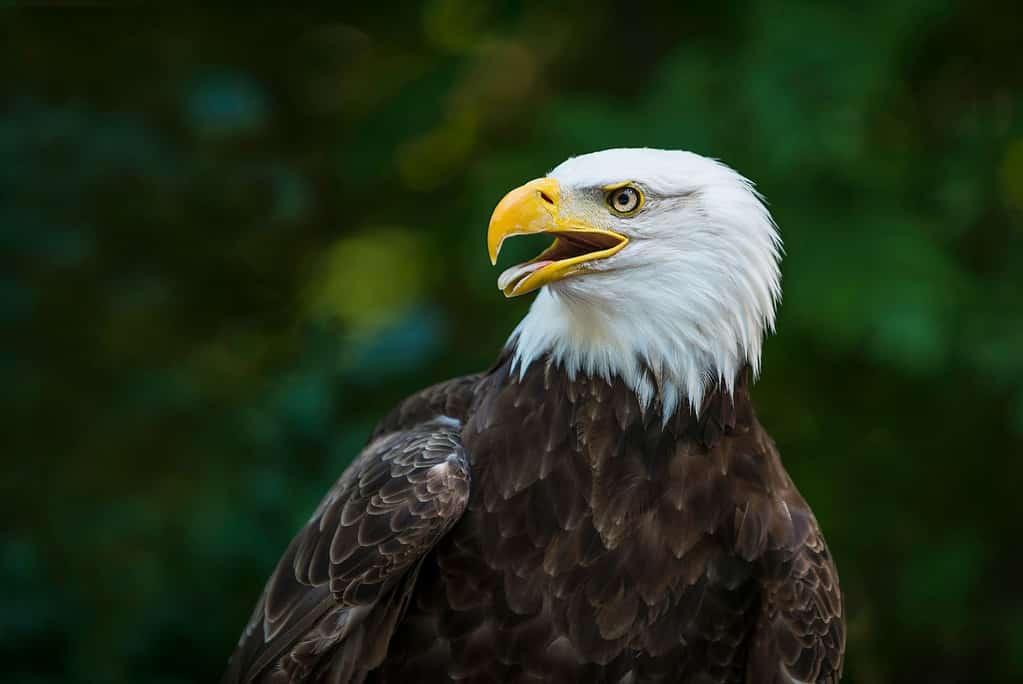
The bald eagle (pictured) is known as a symbol of American freedom and conservation.
©iStock.com/hsun337 – License
2. Broad-Tailed Hummingbird
Classification: Selasphorus platycercus
The colorful and bright broad-tailed hummingbird is predominantly found in the mountainous areas of western North America. This little bird is around four inches long, and its wingspan is about five inches. The back and head of the male are covered in brilliant, iridescent green feathers that shine in the sunlight. Its name originates from its large, rounded tail, which is its most distinguishing characteristic. While many other hummingbird species have bright neck patches, this species’ female has a more subdued green coloration.
Coniferous forests, aspen groves, and alpine meadows are common in the high-altitude habitats where broad-tailed hummingbirds spend their summers breeding. From southern Mexico to the Rocky Mountains in the United States, they are very widespread. These birds are known for their long-distance migration, and they frequently fly great distances to spend the winter in Mexico and Central America.
The nectar from various flowering plants, including wildflowers and human-made hummingbird feeders, makes up the majority of the broad-tailed hummingbird’s diet. They are also known to eat spiders and tiny insects, which are another good source of protein. They can reach nectar deep inside flowers because of their long, narrow bills and unique tongues. These active birds are continuously moving, and their quick wingbeats help them maintain their high metabolic rates.
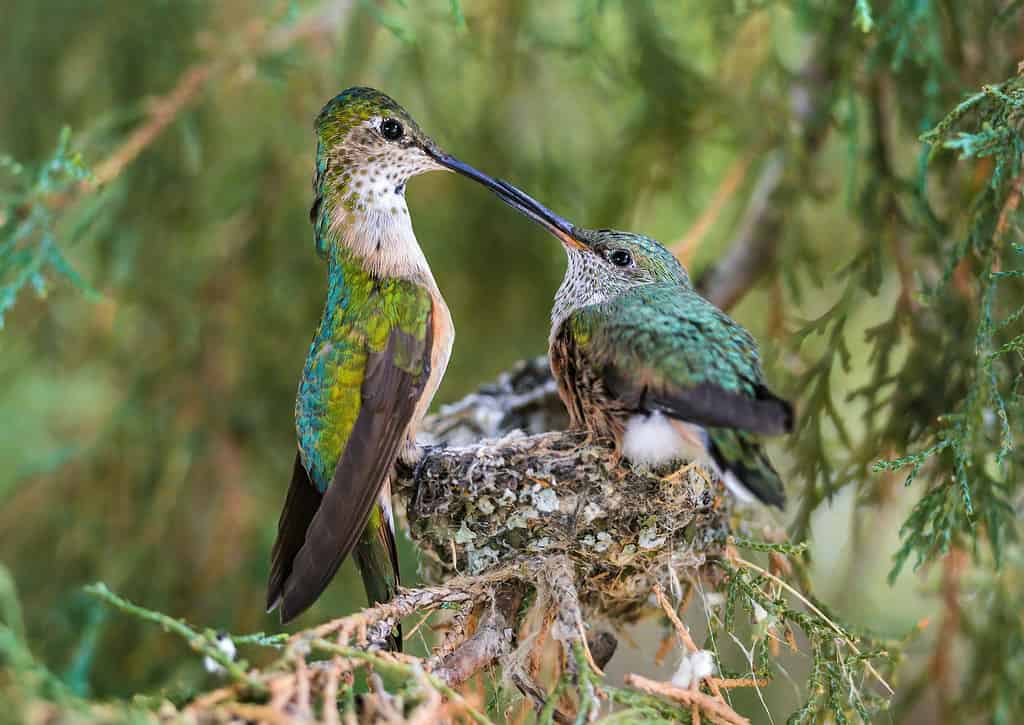
Broad-tailed hummingbirds (pictured) are known for having broader, larger tails than most hummingbird species.
©Susan Hodgson/Shutterstock.com
3. Barn Owl
Classification: Tyto alba
An alluring nocturnal bird known for its recognizable look and eerie sounds, the barn owl is a unique and appealing species. It has a heart-shaped face with a white facial disc that helps guide sound into its ears. The underparts of this bird are often lighter with some speckling whereas the top plumage is normally a delicate, golden-brown tint. The barn owl soars through the night sky with a wingspan of around three to four feet and a body length of 13 to 16 inches.
Barn owls may be found all over the world, including in Europe, Asia, Africa, and the Americas. They frequently reside in open farmlands, meadows, marshes, and woodlands where they may find appropriate nesting areas such as barns, abandoned buildings, caves, and tree hollows. The name “barn owl” relates to the habit of these birds to construct their nests in man-made buildings such as barns.
These raptors hunt largely at night and rely on their keen hearing rather than their vision to find prey. With this keen hearing, barn owls can identify tiny creatures like mice, voles, shrews, and rats just by their sounds. Once they have located their target, they swoop down stealthily and quickly to grab and kill their prey with their razor-sharp claws. Just as well, they eat other tiny animals including birds, insects, amphibians, and sporadically fish.

The barn owl (pictured) is a very well-known bird of prey in North America.
©Imogen Warren/Shutterstock.com
4. Barred Owl
Classification: Strix varia
Another bird that starts with B which is found in North America is the barred owl. It has a medium-sized body that is between 16 and 25 inches long and a wingspan that is between three and four feet long. Dark brown eyes and a large facial disc that is surrounded by brown and white feathers can be seen on its rounded head. The barred owl’s distinctive look is due to its mostly brown plumage with horizontal barring.
These owls may be found in a range of forested environments, such as marshes, deciduous and coniferous woods, and wooded regions close to water sources. Native to North America, they can be found in eastern Canada through the eastern and central states. Their geographic distribution has grown farther west in recent years.
Barred owls are carnivorous predators that mostly eat small animals including mice, voles, squirrels, and rabbits. They also eat insects, birds, reptiles, and amphibians. Barred owls are expert hunters who glide silently through the forest or perch on trees to spot and capture their prey using their keen hearing and low-light eyesight.
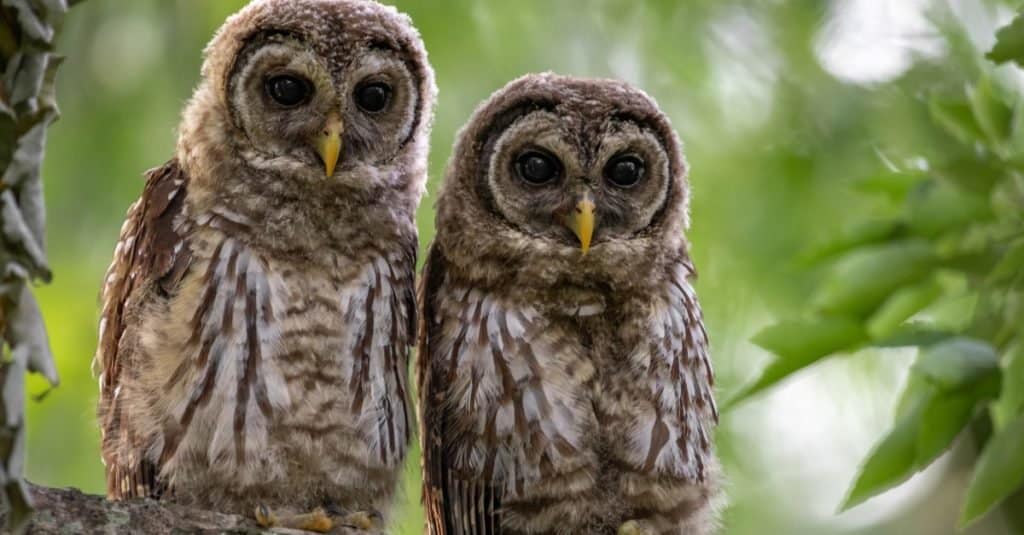
Barred owls (pictured) tend to mate for life and have just one clutch of eggs per year.
©iStock.com/Harry Collins
5. Black-Capped Chickadee
Classification: Poecile atricapillus
The black-capped chickadee is a small, charismatic bird found in North America. It has a distinctive appearance with a black cap and bib contrasting against its white cheeks and throat. Its back is a grayish-brown color, while its underparts are white. The black-capped chickadee has a compact body, measuring around four to five inches in length.
These birds can be found across a wide range of habitats, including deciduous and coniferous forests, woodlands, parks, and suburban areas. They are native to North America, with their range extending from Alaska and Canada to the northern and northeastern regions of the United States.
The black-capped chickadee is primarily an insectivorous bird, feeding on insects, spiders, and caterpillars. However, it also supplements its diet with seeds, berries, and small fruits, especially during the winter months when insects are scarce. These resourceful birds are known for their ability to cache food, storing seeds and other items in bark crevices or hidden spots to retrieve later.
Known for their cheerful and distinct “chick-a-dee-dee-dee” calls, black-capped chickadees are a delight to observe in their natural habitats. Their adaptability, acrobatic foraging behavior, and ability to withstand cold temperatures have made them a beloved species among bird enthusiasts.
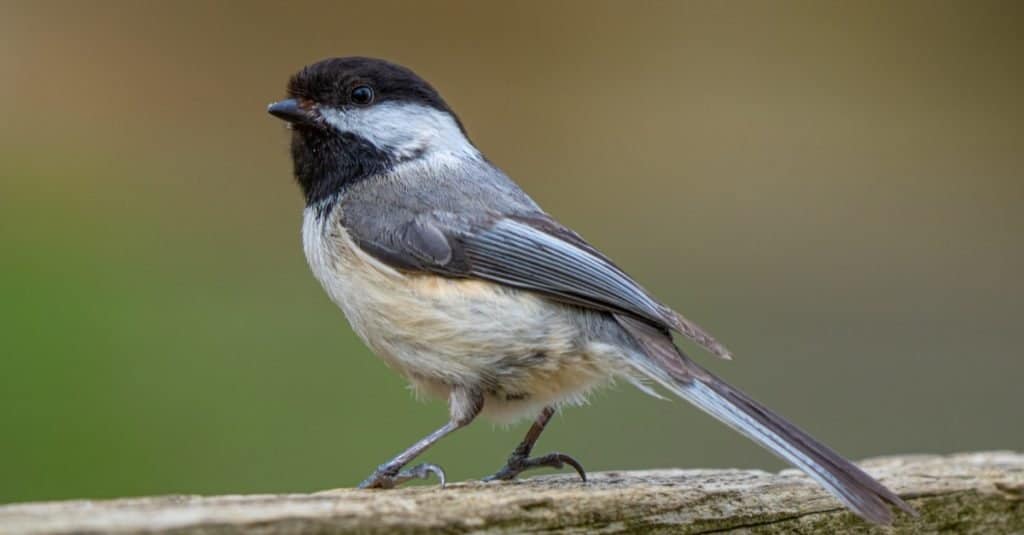
Black-capped chickadee (pictured) is a popular bird among birdwatchers and bird feeders.
©J.A. Dunbar/Shutterstock.com
6. Brambling
Classification: Fringilla montifringilla
A migratory bird with vivid plumage and a distinctive look, the brambling is another worthy entry on our list of birds that start with B. Its body is compact and stocky, measuring five to six inches in length. The breeding plumage of the male brambling is remarkable, consisting of a black head, an orange-buff breast, and a white belly. It has exquisite black and white designs on its back and wings. The males who do not breed and the females of this species have more muted brown and gray tones in their plumage.
The boreal woods of Scandinavia, Russia, and portions of Europe are where these birds nest. They move southward during the winter, and certain areas of southern Europe and Asia are included in their range. During the winter, they are also visible in the British Isles.
Bramblings generally consume seeds, especially those from conifer, birch, and alder trees. They enjoy beech mast, a sort of nut-like seed that beech trees produce. During the mating season, they could add insects and other tiny invertebrates to their diet in addition to seeds. The brambling is a magnificent sight for birdwatchers due to its striking plumage and propensity to migrate in huge flocks in the winter.

The brambling (pictured) is known for its colorful and diverse look.
©ArCaLu/Shutterstock.com
7. Blue Jay
Classification: Cyanocitta cristata
The blue jay is a colorful, perceptive bird that is well-known for both its eye-catching appearance and distinctive vocalizations. It has a striking arrangement of black, white, and blue feathers. With a white face, a crest on the head, and black patterns around the neck and eyes, the body is mostly blue. Strong black-and-white patterns may be seen on the wings and tail. The blue jay is a medium-sized bird, measuring between nine and 12 inches in length.
Native to North America, blue jays can be seen in a range of environments, such as woods, woodlands, parks, and suburban areas. They can be found everywhere from the eastern and central United States to southern Canada.
These birds eat a variety of foods and follow an omnivorous diet. They eat berries, insects, tiny invertebrates, nuts, seeds, and seeds. The capacity of blue jays to hoard and cache food is well documented as well. They gather and store extra food in the ground or tree crevices for later use.
Blue jays have bright colors and unusual cries that are both aesthetically and aurally impressive. They are significant contributions to forest ecosystems due to their tolerance to many settings and their function as seed dispersed.
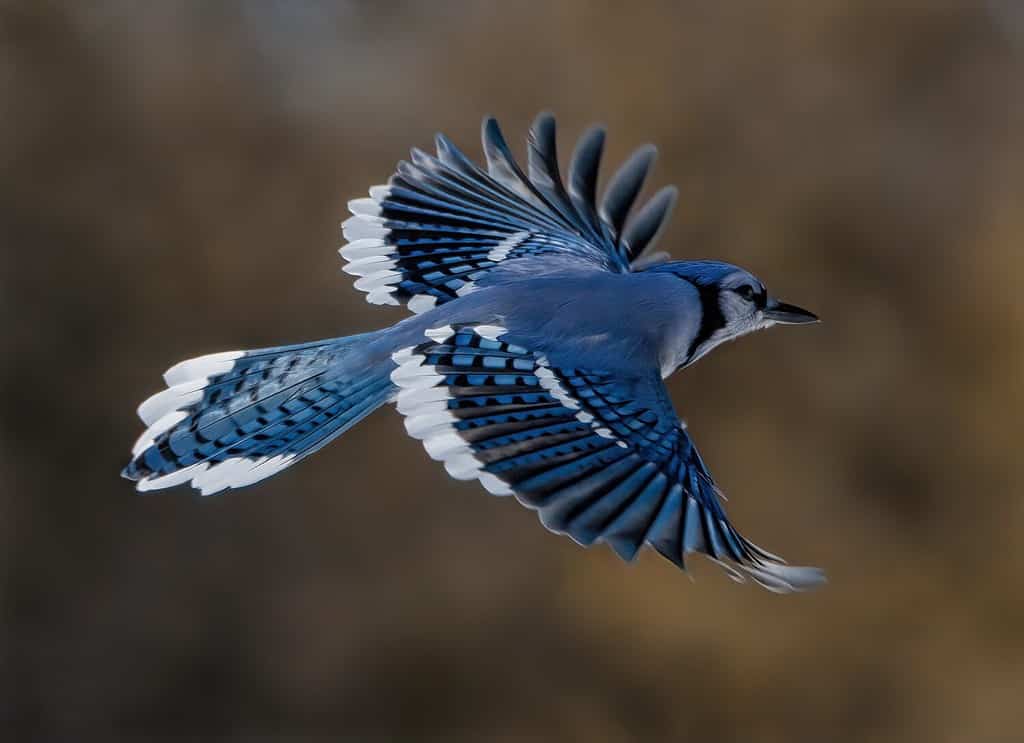
Blue jays (pictured) are known for their very stark and vibrant blue color.
©Fiona M. Donnelly/Shutterstock.com
8. Black-Throated Sparrow
Classification: Amphispiza bilineata
The little and lovely black-throated sparrow is a native of the dry areas of the southwestern United States and northern Mexico. With a conspicuous black neck patch that reaches down to its breast and a distinctive grayish-brown body, it has a distinct and striking look. The bird’s attractiveness is enhanced by its white eye line and the characteristic white patch on its wings. Black-throated sparrows reach an adult length of around six inches.
These sparrows mostly live in arid and semi-arid environments, such as open grasslands, rocky slopes, and desert scrublands. They are frequently seen in portions of northern Mexico and the southwestern United States, including Arizona, New Mexico, Nevada, and California.
The omnivorous black-throated sparrow consumes a wide variety of foods. It consumes seeds, fruits, and insects in its diet. It is known to feed on the ground, pecking at seeds and snatching tiny insects with its bill. Males during the mating season may also consume insects and spiders to supplement their diet and feed their offspring.
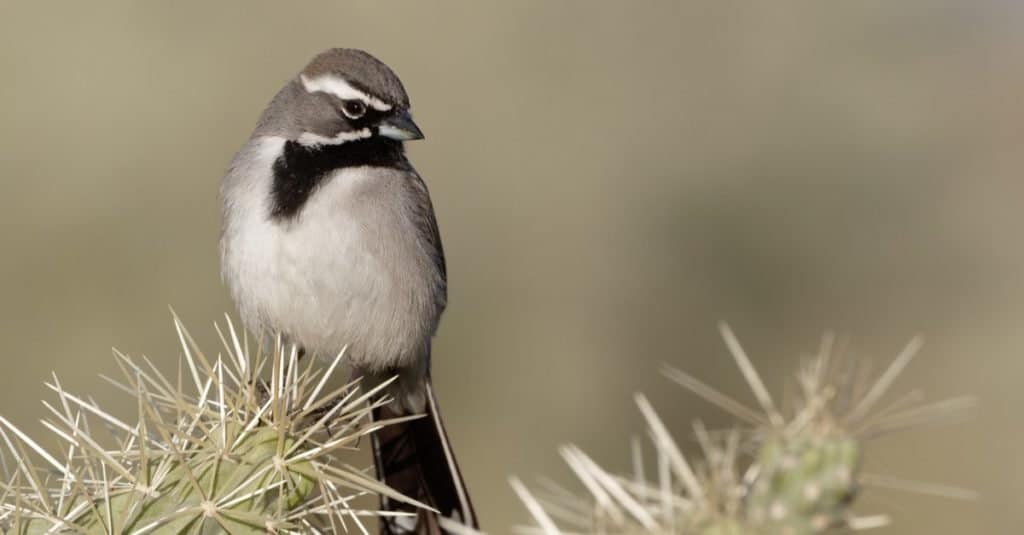
Black-throated sparrows (pictured) are known for perching on cacti with ease in the southwestern United States.
©M. Leonard Photography/Shutterstock.com
The Largest Bird That Starts B
The largest bird that starts with B is the bustard, which is a group of birds from the Otididae family. The interesting bustard is recognized for its enormous size and unusual look. Bustards come from a variety of species, but they all have a muscular bodies, powerful legs, and relatively small necks. They are among the heaviest flying birds due to their large wingspan, which ranges from six to 11 feet. These birds are quite massive!
Around the world, bustards may be found in a variety of environments, including grasslands, savannas, and other dry areas. They are known to live in specific regions of Australia, Asia, Europe, and Africa. Different species have evolved to their surroundings; some do well on wide grasslands while others do better in dry or desert-like settings.
The Fastest Bird that Starts with B
The black-billed magpie is the fasted bird that starts with B. While it may not be the fastest bird overall, among birds with names starting with “B,” the black-billed magpie is known for its impressive aerial speed and agility.
Western North America is home to black-billed magpies, which live in a variety of habitats such as open grasslands, woods, and woodlands. Long tails, stunning black and white plumage, and sharp black beaks are some of their best-known characteristics.
Black-billed magpies have a varied diet that includes insects, fruits, seeds, and small animals, but they are also very opportunistic and will scavenge for carrion when it is around. They can quickly fly through their territory and locate food thanks to the rapid and direct motions of their wings.
The black-billed magpie is a noteworthy avian species that exhibits outstanding flying talents in its way, even if it may not fly as fast as other birds like the peregrine falcon.
More Birds That Start With B
| Bird | Classification |
|---|---|
| Baltimore Oriole | Icterus galbula |
| Brown Pelican | Pelecanus occidentalis |
| Blue-Footed Booby | Sula nebouxii |
| Black-Necked Stilt | Himantopus mexicanus |
| Bewick’s Wren | Thryomanes bewickii |
| Blue Grosbeak | Passerina caerulea |
| Black-Chinned Hummingbird | Archilochus alexandri |
| Bobolink | Dolichonyx oryzivorus |
| Buff-Bellied Hummingbird | Amazilia yucatanensis |
| Bufflehead | Bucephala albeola |
| Black-and-White Warbler | Mniotilta varia |
| Black-Bellied Whistling-Duck | Dendrocygna autumnalis |
The photo featured at the top of this post is © Fiona M. Donnelly/Shutterstock.com
Thank you for reading! Have some feedback for us? Contact the AZ Animals editorial team.







